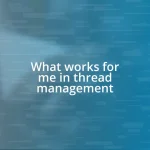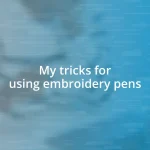Key takeaways:
- Setting clear project goals enhances confidence and emotional connection, transforming embroidery into a meaningful craft.
- Choosing the right materials, including fabric and thread quality, significantly impacts the final outcome of embroidery projects.
- Regularly reviewing and adjusting plans fosters creativity, ensuring projects remain fulfilling and aligned with the artist’s vision.

Setting clear project goals
Setting clear project goals is essential for guiding the direction of your embroidery journey. I remember a time when I started a complex floral design without a clear plan. The result? A lot of frayed threads and frustration! By setting specific goals—like the size of the piece, color palette, and intended use—I found that I approached my projects with more confidence and clarity.
When I reflect on my embroidery projects, I often ask myself, “What do I want to achieve with this piece?” This simple question helps me establish not just the technical aspects, but also the emotional connection. For instance, if I’m creating a gift, I think about the recipient’s preferences and how my embroidery can reflect that. Setting these personalized goals transforms a mere craft into a meaningful creation.
Now, I like to break my project goals into manageable milestones, such as completing the outline before adding color. This approach not only keeps me focused but also provides little victories along the way. Who doesn’t love crossing something off a to-do list? By celebrating these small achievements, I stay motivated, ensuring that my passion for embroidery remains vibrant and fulfilling throughout the entire process.

Choosing the right materials
One of the most vital steps in choosing the right materials for embroidery is understanding the fabric you’re working with. I’ve found that different fabrics can drastically change the appearance of the finished piece. For example, cotton is my go-to for beginners because it’s easy to handle and allows the stitches to shine. In contrast, silk can be more delicate and a bit slippery, making it a challenge for those still mastering the basics. Reflecting on my early projects, I remember tackling a silk embroidery for the first time—it took several attempts to perfect the tension!
Thread selection is equally important. I usually opt for high-quality, colorfast threads that won’t fade over time, especially if the piece is meant to be displayed. As I recall, I once chose a vibrant, cheap thread for a wall hanging, only to see it lose its luster after a few months. I now stick to brands that I know have proven durability and vibrant colors. It’s fascinating how something as simple as the right thread can enhance the overall narrative of a piece.
Lastly, don’t overlook the embroidery tools. Investing in good needles and hoops can elevate your experience. I often tell fellow embroiderers that a properly sized hoop can work wonders for maintaining fabric tension. I remember a project where I used a tension hoop for the first time; it was a game changer! It stood firm while I stitched intricate details, allowing me to focus on my creativity rather than worry about puckering or shifting fabric.
| Material Type | Best Used For |
|---|---|
| Cotton | General embroidery, easy handling |
| Silk | Advanced designs, elegant appearances |
| Thread Quality | Durability, colorfastness |
| Hoops | Maintaining fabric tension |

Developing a detailed timeline
Developing a detailed timeline for my embroidery projects has been a game changer in managing my time and resources effectively. I can still vividly recall starting a large piece with no clear timeline, leading to disarray and stress. Now, I break down the project into phases—sketching, choosing colors, stitching, and finishing—each with specific deadlines. This structured approach helps me to allocate my time wisely and keeps me engaged and excited throughout the journey.
Here’s how I typically break it down:
- Sketching: 1-2 days for initial designs.
- Materials Gathering: 1 day for purchasing threads and fabric.
- Stitching: 1-2 weeks (depending on complexity).
- Finishing Touches: 2-3 days for framing or washing the piece.
I love setting mini-deadlines for each stage; this anticipation fuels my passion. For instance, while working on a meaningful gift for a friend, the countdown to gifting day turned stitching into a joyous ritual. It wasn’t just about completing the project; it was about infusing each stitch with love as I raced against the clock to finish before her birthday. Those moments are what keep my creativity alive and make every embroidery project memorable.

Organizing your workspace effectively
Organizing your workspace effectively can make all the difference in your embroidery journey. I remember when my table was cluttered with threads, needles, and fabric scraps, I found myself sifting through a chaotic mess just to find my favorite shade of green. Since then, I’ve established a designated spot for each item; it not only saves time but it also allows me to focus on what truly matters—the art of stitching. A simple tray for my tools and containers for my threads has worked wonders for me.
I also invest in clear storage bins for my fabrics, which allows me to easily see and access my materials. This transparency has sparked much more creativity as I often flip through my fabric collection, letting the colors inspire me on a whim. Have you ever found that the right fabric practically jumps out at you? It’s like a lightbulb moment when you see that perfect piece waiting in your organized stash.
To top it off, I keep a small bulletin board above my workspace filled with inspirational pieces and notes. This constant visual reminder fuels my enthusiasm and creativity. I recall glancing up at a beautiful embroidery design I pinned from a workshop I attended; it reignited my passion during a period of artistic stagnation. Have you ever experienced that kind of spark from your surroundings? Having an organized area not only clears the clutter but also creates an inviting atmosphere for crafting.

Tracking project progress
Tracking my project progress has become an essential part of my embroidery journey that I genuinely look forward to. I often use a simple checklist or a dedicated notebook; seeing those small boxes fill up with checked items elicits a sense of accomplishment that keeps me motivated. Have you ever felt that thrill when crossing off an item, no matter how tiny it seems? For me, it reaffirms my commitment to the craft and infuses a little spark of joy into my stitching sessions.
I also like to incorporate visual markers into my tracking. Taking progress photos has turned into a delightful ritual—I snap a picture after completing each significant phase. It allows me to visually see how far I’ve come, and sometimes, I find myself smiling as I reflect on the evolution of the piece. On particularly challenging projects, this practice often becomes a source of reassurance when I feel bogged down by intricate details. Isn’t it amazing how photographs can serve as a tangible record of your journey?
Lastly, I set up regular check-in points to assess not just my progress, but also my emotional state. After powering through long stitching nights, I pause to ask myself, “Am I enjoying this?” This self-reflection helps me regain focus if I start to feel overwhelmed. For instance, during a recent project that felt daunting, those check-ins helped me recognize the need for a short break. I stepped away and came back refreshed, ready to pour my heart into stitching again. How do you ensure that your creative journey remains fulfilling? Recognizing those moments of renewal is key to keeping your passion alive.

Reviewing and adjusting your plan
Reviewing your plan is a vital step in ensuring your embroidery project stays on track. There have been times when I’ve committed to a design, only to realize halfway through that my initial vision no longer excites me. Have you ever felt that disconnect? In those moments, I remind myself that it’s perfectly okay to pivot. I take a little time to reassess my materials, techniques, and even the design itself, which often leads to fresh inspiration and creative breakthroughs.
As I evaluate my progress, I’ve found it helpful to keep a journal handy. I jot down what’s working and what isn’t, and I often include an emotional check-in. Just the other day, while stitching a particularly intricate floral pattern, I noticed frustration creeping in. Instead of pushing through, I wrote down my feelings and realized I needed to simplify the design to keep my joy intact. Isn’t it incredible how a few words can clarify your next steps?
Sometimes, adjusting my plan is as simple as shifting the timeline. I’ve learned not to rush my projects, especially when they’re close to my heart. For instance, I often extend deadlines when I’m inspired to experiment or explore new stitches. I’ll ask myself, “Will taking a bit more time lead to a masterpiece?” Usually, it does. Embracing flexibility in my planning helps me nurture my creativity while honoring my emotional journey, leading to projects that are not just finished but truly satisfying.
















